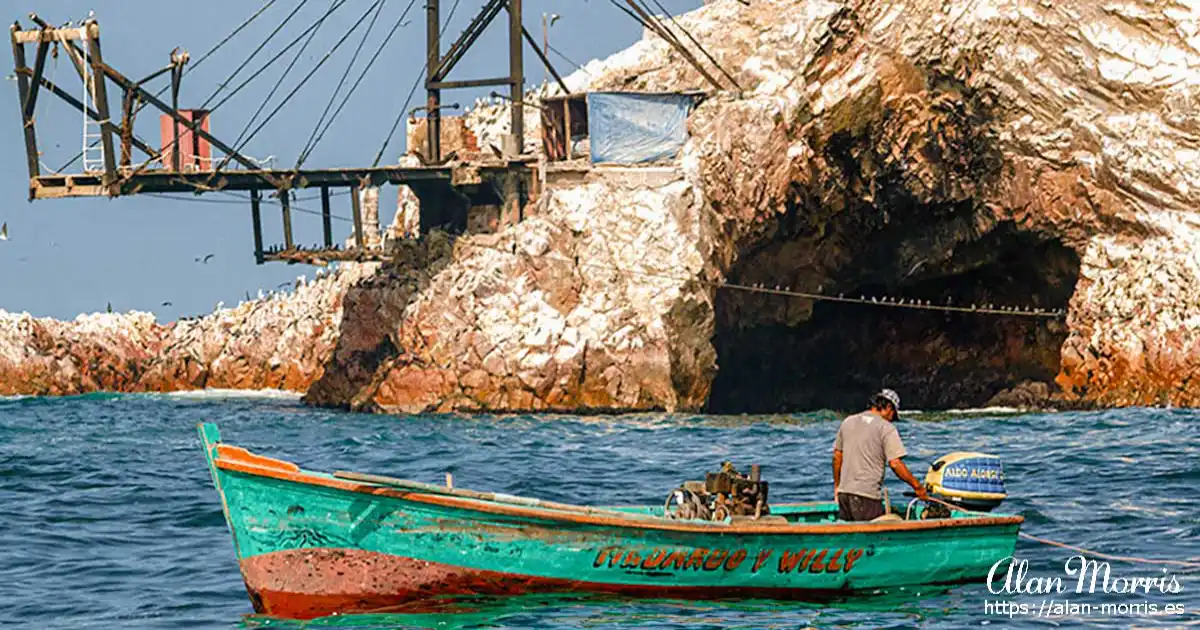Today we set off early to take a boat trip out to the Ballestas Islands, a protected area that is home to Humboldt Penguins, Peruvian Pelicans, Peruvian Booby, Neotropic Cormorants, Inca Terns and Sea Lions.
We set out on a speedboat for a half-hour trip out to the islands. This in itself was great fun. Even before getting on the boat to the islands, we were treated to the site of Peruvian Pelicans close up, on the beach, where locals were feeding them in the hope of getting a tip from the photographers going out to the islands.
Paracas Candelabra.
We passed the impressive Paracas Candelabra on the way to the Ballestas Islands.
Although the exact age of the Candelabra geoglyph is unknown, archaeologists have found pottery around the site dating back to around 200 BC. This pottery likely belonged to the Paracas people, although whether they were involved in the creation of the geoglyph is not known. The reason for the Candelabra's creation is also unknown. However, it is most likely a representation of the trident, a lightning rod of the god Viracocha, who was seen in mythology throughout South America. It has been suggested that the Candelabra was built as a sign to sailors or even as a symbolic representation of a hallucinogenic plant called Jimson weed.
Ballestas Islands.
The Ballestas Islands are a group of small islands near the town of Pisco located within the Paracas District of the Pisco Province in the Ica Region on the south coast of Peru. They are mainly composed of rock formations and cover an estimated area of 0.12 km².
On the trip out, we saw dolphins and sea lions swimming alongside our boat, playing in its wake. Once we got to the islands, we were not disappointed. The wildlife was amazing. There were thousands of birds, including Peruvian Pelicans, Neotropic Cormorants, Peruvian Boobies, Inca Terns and Humboldt Penguins. Like all the birds, many sea lions basked on rocks and swam in the sea. Some of the mother Sea lions taught their pups to climb onto the rocks.
Photos from the Ballestas Islands.
The guano on the islands is collected every five to seven years by the locals to sell as a fertiliser. The fisherman could also be seen using hand lines to catch fish for their family and to sell to make a living.
After visiting the islands, we visited a local private museum in Pisco, which had a collection of locally collected skulls that proved the advanced medical knowledge the Incas used to have.
Nazca Lines.
After leaving Pisco, we continued our trip and went on our overnight stay in Nazca. On the way, we stopped to climb a flimsy iron tower erected before health and safety was invented to look down on the fantastic Nazca Lines. The coach parked on one side of the road, allowing anyone who wanted to climb the viewing tower on the other side to first play chicken with all the cars, lorries and coaches hurtling along the dusty road through the desert.
The Nazca Lines were impressive. From the top of the swaying tower, which I clung to whilst trying to get a photo of the two nearest designs, I could imagine the huge size and technology of the advanced spaceships that I believe brought alien visitors to this spot hundreds of years ago to make such awesome symbols. That is until I heard the story from our local tour guide of how they were, in fact, made by the Nazca people themselves as a tribute to their gods.
